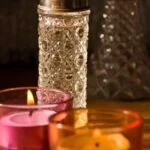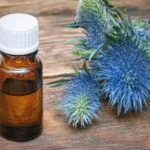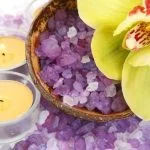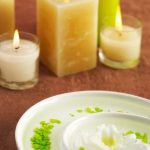Aromatherapy bath treatment has gained popularity as a holistic and therapeutic practice that promotes relaxation and overall well-being. This article aims to provide a comprehensive understanding of this concept, beginning with a brief overview of the history and origins of aromatherapy. By delving into the benefits and purposes of aromatherapy bath treatments, readers will gain insights into how this practice can address both physical and mental health concerns.
Dating back thousands of years, aromatherapy has its roots in ancient civilizations such as Egypt, China, and India. These cultures recognized the potent effects of essential oils derived from plants on the body, mind, and spirit. Today, aromatherapy continues to be embraced for its natural healing properties as it harnesses the power of plant extracts.
The benefits of aromatherapy bath treatments are manifold. Not only can they improve physical ailments such as muscle tension or skin conditions, but they also have profound effects on one’s emotional well-being.
Whether it is relieving stress, enhancing mood or promoting relaxation after a long day, aromatherapy bath treatments offer a multi-faceted approach to self-care. As we delve deeper into this subject in subsequent sections, we will explore different essential oils commonly used in these treatments and learn how they work therapeutically to promote healing and balance within the body.
Exploring Essential Oils for Aromatherapy Bath Treatments
When it comes to aromatherapy bath treatments, essential oils play a vital role in providing both the therapeutic benefits and delightful scents that enhance the experience. There are numerous types of essential oils available, each with its own unique properties and potential health benefits. Here, we will explore some of the most commonly used essential oils in aromatherapy bath treatments and how they can contribute to your overall well-being.
- Lavender: Known for its calming and relaxing effects, lavender essential oil is a popular choice for promoting sleep and reducing anxiety and stress. It is also valued for its ability to soothe skin irritations and relieve muscle tension.
- Eucalyptus: With its refreshing and invigorating scent, eucalyptus essential oil is often used in aromatherapy bath treatments to clear sinuses, alleviate respiratory congestion, and provide relief from colds or allergies. Its antiseptic properties also make it beneficial for supporting healthy skin.
- Peppermint: Peppermint essential oil is widely recognized for its cooling sensation and uplifting aroma. It can help improve mental clarity, reduce headaches, relieve muscle pain, and even aid digestion. Its revitalizing properties make it an excellent choice for an energizing bath experience.
- Chamomile: Renowned for its calming effects on both the mind and body, chamomile essential oil is frequently used to promote relaxation and restful sleep. It can also soothe irritated skin conditions such as eczema or dermatitis due to its anti-inflammatory properties.
To reap the full therapeutic benefits of these essential oils during your aromatherapy bath treatment, it’s important to understand how they work. Essential oils contain concentrated plant compounds that are absorbed through inhalation or skin contact. When mixed with warm bathwater, their molecules become airborne, creating a soothing atmosphere that stimulates our senses and promotes relaxation. Additionally, these natural compounds can enter the bloodstream through the skin, where they exert their therapeutic effects on various systems within the body.
Incorporating essential oils into your aromatherapy bath treatment introduces a whole new dimension to your bathing experience. Whether you’re seeking stress relief, skin rejuvenation, or respiratory support, there is an essential oil that can meet your needs and enhance your overall well-being.
Preparing for the Ultimate Aromatherapy Bath Experience
Creating a tranquil environment is essential to fully immerse yourself in the ultimate aromatherapy bath experience. Here are some tips to help you set the right mood and ambiance in your bathroom:
- Create a serene atmosphere: Clear any clutter or distractions from your bathroom space. Keeping it clean and organized will promote a sense of calmness and relaxation. Consider adding plants, such as lavender or eucalyptus, to bring a touch of nature into your surroundings.
- Lighting: Opt for soft, dim lighting instead of harsh overhead lights. Use candles or tea lights to create a soothing ambiance. You can also invest in color-changing LED lights that emit a gentle glow, promoting relaxation and enhancing the overall sensory experience.
- Music: Selecting the right music can greatly enhance your aromatherapy bath treatment. Choose calming instrumental or nature sounds that resonate with you, such as classical music or soothing ocean waves. Play it softly in the background to help you unwind and de-stress.
- Scents: Incorporating scents into your bath experience can heighten relaxation and provide additional therapeutic benefits. Add a few drops of essential oils into your bathwater or use scented candles or incense sticks to create an inviting aroma.
To take complete advantage of your aromatherapy bath treatment, set aside uninterrupted time for this self-care practice. Leave your phone outside the bathroom and disconnect from any distractions that may disrupt your relaxation.
Once you have created an optimal environment, you can proceed to indulge in an aromatherapy bath that not only revitalizes your body but also rejuvenates your mind and spirit.
Step-by-Step Guide
Taking an aromatherapy bath can be a wonderful and indulgent experience that promotes relaxation and enhances overall well-being. To ensure you get the most out of your aromatherapy bath, it is important to follow a step-by-step guide. This section will provide detailed instructions on how to properly prepare your bath and make the most of your aromatherapy experience.
Firstly, start by creating a peaceful and tranquil atmosphere in your bathroom. Clear any clutter and create a clean space that allows you to fully relax. Dim the lights or use candles for soft, soothing lighting. Consider playing calming music or nature sounds to further enhance the ambiance. These elements will help set the mood for your aromatherapy bath.
Next, choose the essential oils that you would like to incorporate into your bath. Different essential oils have different therapeutic properties and benefits, so select oils that align with your intended purpose. For example, lavender oil is known for its calming and stress-relieving properties, while citrus oils like lemon or grapefruit can uplift and energize.
When preparing your bath, start by filling the tub with warm water at a temperature that is comfortable for you. Be sure to test the heat before getting in to avoid any discomfort or burns. As the tub fills, add a few drops of your chosen essential oil(s) directly into the water or mix them with a carrier oil or another bathing product like Epsom salts.
Once you have added the essential oils, give the water a gentle swirl to disperse them throughout the bath. Take some time to breathe in deeply and inhale the aromatic scent as it fills the room. This deep breath can already begin to relax and calm your mind.
Finally, immerse yourself in the bath slowly and allow yourself to fully relax into it. Stay in the bath for around 20-30 minutes to fully absorb the benefits of aromatherapy. Close your eyes, take slow breaths, and soak in the soothing properties of the essential oils.
Taking a step-by-step approach to your aromatherapy bath ensures that you create the most optimal environment for relaxation and healing. By following these instructions, you can fully embrace the benefits of aromatherapy and enjoy a rejuvenating bath experience.
The Benefits and Healing Properties of Aromatherapy Bath Treatment
Aromatherapy bath treatments offer a wide range of physical and mental health benefits, making them an ideal self-care practice for relaxation and healing. The use of essential oils in the bath water allows for the absorption of therapeutic properties through both inhalation and skin contact. This section explores the various benefits and healing properties that aromatherapy bath treatments can provide.
One of the key benefits of aromatherapy bath treatments is stress relief. Essential oils such as lavender, chamomile, and bergamot have calming properties that help to reduce anxiety and promote relaxation. The warm water combined with these soothing scents creates a tranquil atmosphere that can aid in relieving tension and promoting a sense of calm.
In addition to stress relief, aromatherapy bath treatments can also improve sleep quality. Certain essential oils like chamomile, clary sage, and ylang-ylang have sedative effects that can help to induce sleep and improve overall sleep duration and quality. Taking a warm bath infused with these oils before bedtime can be especially beneficial for those struggling with insomnia or irregular sleep patterns.
Furthermore, aromatherapy bath treatments have been found to have mood-enhancing effects. Essential oils like citrus (such as lemon or orange), rosemary, and peppermint have stimulating properties that can boost mood, energy levels, and focus. Taking a bath enriched with these invigorating scents can help uplift your spirits and increase alertness.
To summarize, the benefits of aromatherapy bath treatments include stress relief, improved sleep quality, enhanced mood, increased relaxation, and overall well-being. Incorporating this self-care practice into your routine can provide you with much-needed relaxation amidst a hectic lifestyle while contributing to your physical and mental health.
| Benefit | Corresponding Essential Oils |
|---|---|
| Stress Relief | Lavender, Chamomile, Bergamot |
| Improved Sleep Quality | Chamomile, Clary Sage, Ylang-Ylang |
| Mood Enhancement | Citrus (Lemon, Orange), Rosemary, Peppermint |
Exploring Different Aromatherapy Bath Recipes and Combinations
One of the most enticing aspects of aromatherapy bath treatments is the ability to create personalized experiences through different combinations of essential oils. By blending various oils together, individuals can enhance their bathing rituals and target specific areas of concern. Whether you’re looking for a relaxing, invigorating, or mood-boosting experience, there are countless aroma combinations to explore.
Popular Essential Oil Combinations for Specific Purposes
- Soothing Blend: For those seeking relaxation and stress relief, a combination of lavender and chamomile essential oils is highly recommended. Lavender promotes calmness and helps to balance emotions, while chamomile has sedative properties that aid in soothing restlessness.
- Energizing Blend: To revitalize the body and mind, consider blending stimulating oils like peppermint and citrus-based options such as lemon or grapefruit. Peppermint refreshes while providing mental clarity, while citrus scents uplift the spirits and increase energy levels.
- Uplifting Blend: If you’re in need of a mood boost or want to promote positivity during your bath, try combining bergamot and ylang-ylang essential oils. Bergamot has mood-enhancing properties that promote feelings of joy and serenity, while ylang-ylang is known for its aphrodisiac qualities and ability to reduce anxiety.
Recipes for Soothing, Energizing, or Uplifting Bath Experiences
1. Soothing Bath Recipe:
- 6 drops of lavender essential oil.
- 4 drops of chamomile essential oil.
- 2 tablespoons of carrier oil (such as almond or jojoba).
Combine the essential oils with the carrier oil before adding them to your bathwater. Swirl the mixture gently to disperse evenly throughout the water.
2. Energizing Bath Recipe:
- 4 drops of peppermint essential oil.
- 2 drops of lemon essential oil.
- 2 drops of grapefruit essential oil.
Add the essential oils directly to your bathwater and use your hand or a spoon to agitate the water and disperse the oils.
3. Uplifting Bath Recipe:
- 4 drops of bergamot essential oil.
- 2 drops of ylang-ylang essential oil.
Combine the essential oils before adding them to your bathwater. Mix well to ensure even distribution.
Remember to always dilute essential oils properly and test for personal sensitivities before using new combinations. Adjust the number of drops based on personal preference, but never exceed the recommended dosage to avoid overwhelming scents or potential skin irritations.
By exploring different aromatherapy bath recipes and combinations, individuals can tailor their bathing experiences to meet their specific needs and desires. Whether you’re in need of relaxation, energy, or an uplifted mood, there are endless possibilities for creating a truly customized and enjoyable aromatherapy bath experience.
Safety Precautions and Considerations for Aromatherapy Bath Treatment
Proper Dilution of Essential Oils
When engaging in aromatherapy bath treatments, it is crucial to dilute essential oils properly before adding them to your bathwater. Undiluted essential oils can be too potent and harsh on the skin, potentially causing irritation or allergic reactions. To ensure safety, it is recommended to use carrier oils such as coconut oil, jojoba oil, or sweet almond oil to dilute the essential oils before adding them to the bath.
The general guideline for dilution is around 5 drops of essential oil per ounce of carrier oil. However, this ratio can vary depending on personal preference and sensitivity levels. It is always advisable to start with a lower concentration and gradually increase if necessary. If you have sensitive skin or are using essential oils for the first time, perform a patch test on a small area of your skin before immersing yourself in a full aromatherapy bath.
Addressing Potential Allergic Reactions or Sensitivities
While aromatherapy bath treatments offer numerous benefits, it is important to be aware of potential allergies or sensitivities to certain essential oils. Some individuals may experience adverse reactions when exposed to specific scents or compounds present in essential oils. Common allergenic essential oils include lavender, chamomile, and tea tree.
If you have known allergies or sensitivities to certain plants or fragrances, it is recommended that you consult with a healthcare professional or an aromatherapist before incorporating that particular essential oil into your bath routine. They will be able to guide you on suitable alternatives or provide advice on safe usage.
Additionally, individuals who are pregnant should exercise caution when using certain types of essential oils during their baths. Some essential oils have been associated with potential risks during pregnancy and should be avoided altogether. It is always best to consult with a healthcare provider prior to using any new products during pregnancy.
Other Safety Precautions
In addition to proper dilution and consideration of allergies or sensitivities, there are a few other safety precautions to keep in mind when practicing aromatherapy bath treatments.
Firstly, it is important to ensure that the essential oils used are of high quality and sourced from reputable brands or suppliers. Poor quality oils may be adulterated or contaminated, which can compromise their effectiveness and potentially cause harm.
Secondly, avoid using essential oils in excessive quantities as this can overload your system and lead to adverse effects. Follow the recommended dosage guidelines provided by experts or consult with a qualified aromatherapist for personalized guidance.
Lastly, always exercise caution when getting in and out of the bathtub. Essential oils can make surfaces slippery, so it is crucial to have good traction and sturdy handrails if necessary. Take your time when moving around to prevent any accidents or injuries during your aromatic bathing experience.
By following these safety precautions and considerations, you can enjoy the benefits of an aromatherapy bath treatment while ensuring a safe and pleasurable experience.
Enhancing Your Aromatherapy Bath Routine with Additional Elements
In addition to essential oils, there are several other elements that can be incorporated into your aromatherapy bath routine to enhance the overall experience and maximize the therapeutic benefits. By combining these additional elements with aromatic oils, you can create a truly indulgent and rejuvenating bath experience.
One popular addition to an aromatherapy bath is bath salts. Bath salts are a great way to enhance relaxation and promote detoxification. They can help soothe sore muscles, reduce inflammation, and improve circulation. When choosing bath salts for your aromatherapy bath, look for ones that are infused with essential oils that complement the oils you plan to use in your bath. This will create a harmonious blend of scents and therapeutic properties.
Another element to consider is herbal infusions. Adding herbs such as lavender, chamomile, or rose petals to your bathwater can provide additional soothing and calming effects. These herbs have been used for centuries for their aromatic and healing properties. Simply place the herbs in a muslin bag or tea strainer and allow them to steep in hot water before adding it to your bath.
If you’re looking for a more luxurious and indulgent experience, consider using a bath bomb. Bath bombs are compacted mixtures of dry ingredients such as baking soda, citric acid, and Epsom salts that dissolve when they come into contact with water. They often contain fragrant essential oils that release pleasant scents while also moisturizing and softening the skin.
To further enhance your aromatherapy bath routine, consider incorporating complementary practices like meditation or mindfulness techniques while bathing. This can deepen your relaxation and promote mental clarity. As you soak in the warm water filled with aromatic scents, try focusing on your breath or repeating positive affirmations to enhance the overall mind-body connection.
By incorporating these additional elements into your aromatherapy bath routine, you can take your self-care practice to the next level. Whether you choose to use bath salts, herbal infusions, bath bombs, or engage in mindfulness practices, these additions will enhance the therapeutic benefits and create a truly enjoyable and rejuvenating experience.
Frequently Asked Questions and Common Misconceptions about Aromatherapy Bath Treatment
As aromatherapy bath treatment gains popularity, it is natural for people to have questions and concerns about its effectiveness and safety. In this section, we will address some of the frequently asked questions and common misconceptions surrounding aromatherapy bath treatment to provide clarity and guidance.
One common question that arises is whether aromatherapy bath treatment is just a placebo effect or if it truly has therapeutic benefits. While individual experiences may vary, numerous studies have shown that essential oils used in aromatherapy have various healing properties.
The inhalation or absorption of these oils during a bath can promote relaxation, reduce stress and anxiety, relieve muscle tension, improve sleep quality, and even enhance mood. However, it is important to note that aromatherapy should not be seen as a replacement for medical treatments but rather as a complementary practice to support overall well-being.
Another frequently asked question revolves around the safety of using essential oils in an aromatherapy bath. Dilution is key when using essential oils directly on the skin or adding them to your bathwater. Essential oils are highly concentrated substances and should never be applied undiluted to the skin as it may cause irritation or allergic reactions.
It is recommended to dilute essential oils with a carrier oil or dispersing agent before adding them to your bathwater. Additionally, some individuals may have specific allergies or sensitivities, so it is crucial to do a patch test before using any new essential oil.
A common misconception about aromatherapy bath treatment is that it requires expensive equipment or special baths. In reality, all you need is a bathtub and your chosen essential oils. You can create a relaxing atmosphere by dimming the lights, playing soothing music, and using candles or diffusers to enhance the scent in the room. Aromatherapy baths can easily be incorporated into your self-care routine without breaking the bank.
By addressing these frequently asked questions and debunking common misconceptions, we hope to provide readers with the necessary information to confidently explore aromatherapy bath treatment. Remember to consult with a qualified aromatherapist or healthcare professional if you have specific concerns or medical conditions before starting this practice.
Conclusion
In conclusion, aromatherapy bath treatment offers a unique and effective way to relax, unwind, and promote healing for both the body and mind. Throughout this article, we have explored the history and origins of aromatherapy, discussing its many benefits and purposes. We have also delved into the different types of essential oils commonly used in aromatherapy bath treatments, highlighting their therapeutic properties and how they work to enhance overall well-being.
Preparing for an aromatherapy bath experience involves creating a tranquil atmosphere in your bathroom, setting the right mood with lighting, music, and scents. Following a step-by-step guide on properly preparing your bath ensures that you are maximizing the benefits of the essential oils while maintaining safety precautions. The physical and mental health benefits of aromatherapy bath treatments cannot be underestimated as they help alleviate stress, anxiety, promote relaxation, and provide numerous healing properties.
Exploring different aroma combinations and recipes allows for personalized experiences tailored to specific needs or desires. Safety precautions regarding dilution of essential oils are paramount to avoid allergic reactions or sensitivities. Enhancing your aromatherapy bath routine with additional elements such as bath salts or herbal infusions can further enhance the therapeutic effects.
Incorporating mindfulness or meditation during bathing is another complementary practice that can deepen the relaxation experience. By embracing the relaxation and healing powers of aromatherapy bath treatment, individuals can take steps towards cultivating self-care practices that prioritize their overall wellness. Whether soothing sore muscles or finding solace in moments of solitude, an aromatherapy bath offers a rejuvenating escape from daily stressors.
To truly embrace these benefits and enhance your wellness routine, it is time to explore the world of aromatherapy bath treatment firsthand. Incorporate this soothing self-care practice into your life by setting aside regular moments for pampering yourself with an indulgent soak fragrant with essential oils. Allow yourself to fully immerse in the tranquility and healing powers of aromatherapy and experience the transformative effects it can have on your overall well-being.
Frequently Asked Questions
How do you use aromatherapy bath?
Aromatherapy baths are a popular way to enjoy the benefits of essential oils. To use aromatherapy bath products, start by filling your bathtub with warm water. Then, add a few drops of your chosen essential oil or a pre-made aromatherapy bath product to the water. Swirl the water around to ensure that the oil is evenly distributed throughout the bath.
Before getting in, take a moment to inhale deeply and appreciate the calming scents. Once you’re in the bath, relax and soak for at least 15-20 minutes to allow the oils to work their magic on your senses and skin. Remember to always follow safety guidelines and dilution ratios when using essential oils in baths.
What does aromatherapy treatment involve?
Aromatherapy treatments involve using essential oils derived from plants for healing purposes. These treatments can take various forms depending on individual preferences and needs, but common methods include inhalation, topical application, or even ingestion under professional guidance.
When receiving professional aromatherapy treatment, you will typically go through an initial consultation where the therapist assesses your health concerns and creates a customized blend of essential oils based on your specific needs. The treatment itself may involve massage with diluted essential oils, applying compresses soaked in essential oil-infused water, or even using diffusers to disperse scents into the air for inhalation.
How long does aromatherapy treatment last?
The duration of an aromatherapy treatment session can vary depending on several factors such as personal preference, specific goals, and individual therapist practices. Generally, an aromatherapy treatment can last anywhere from 60 minutes to 90 minutes per session. However, it’s important to note that this timeframe often includes not only administering the essential oil therapies but also time for pre-treatment consultation and post-treatment relaxation periods.
Additionally, some shorter sessions lasting 30 minutes may exist for certain targeted applications like quick stress relief or as part of express spa treatments. Ultimately, discussing treatment duration with a qualified aromatherapy practitioner will help determine the most suitable timeframe for your specific needs.

Are you looking for a natural way to improve your health and wellbeing?
If so, aromatherapy may be the answer for you.





